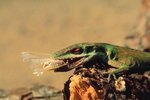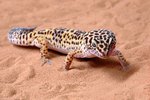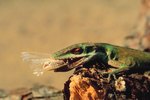
The familiar green and brown colorations are only the beginning when it comes to the gecko, a nonblinking, warm-weather lizard. With more than 1,400 species that live in a wide range of habitats, geckos display nearly every hue, as well as decorative spots and patterns.
Brown and Gray Geckos
Shades of brown or gray adorn most geckos around the world, found except in northeastern North America, northern Eurasia and Antarctica. These camouflaging colors help the geckos hide among rocks, dirt and sand from predatory birds such as eagles and hawks. Among the brown geckos are common house geckos (Hemidactylus frenatus), African fat tail geckos (Hemitheconyx caudicinctus), stump-toed geckos (Gehyra mutilata) and the Namib sand gecko, also known as the web-footed gecko (Pachydactylus rangei). Gray species include the Mediterranean gecko (Hemidactylus turcicus), native to Southern Europe and Northern Africa, and the Indo-Pacific Gecko (Hemidactylus garnotii), native to Southeast Asia, which are now firmly established in Florida.
Green Geckos
Green gecko species include the Madagascar giant day gecko (Phelsuma madagascariensis), one of the largest geckos in the world. It grows up to 9 inches long in its native habitat on the Big Red Island. Among the more unusual species is New Zealand's bright green barking gecko (Naultinus punctatus), which actually barks at predators to warn them away.
Yellow Geckos
The popular pet leopard gecko (Eublepharis macularis) has a bright yellow skin covered with brown spots. Unlike other geckos, this native of Afghanistan, India and Pakistan has eyelids. Another pair of yellow geckos, Lygodactylus kimhowelli and L. picturatus, share the common name of yellow-headed dwarf gecko. L. kimhowelli has a pale yellow head with a blue body while L. picturatus has a bright yellow head and a pale blue body. Both of these 3-inch-long geckos are native to East Africa.
Blue Geckos
The blue-tailed day gecko (Phelsuma cepediana) from Mauritius and electric blue day gecko (Lygodactylus williamsi) from Tanzania share this unusual color. Both of these geckos are active during daylight hours, basking in the sun in their native habitats or under a compact UV bulb when raised in captivity.
Orange and Red Geckos
The crested gecko (Rhacodactylus ciliatus), also known as the eyelash gecko, Guichenot's giant gecko and New Caledonian crested gecko, was believed extinct until it was rediscovered in 1994. Growing up to 10 inches long in its native habitat of New Caledonia, it may be found shades of in red, orange, yellow, brown or gray. The orange-spotted tokay gecko (Gekko gecko) has a pale gray or blue background of scales covered with orange spots. It makes a series of loud noises, including its signature cry, "Tokay, tokay." Unlike other geckos, handling this reptile isn't the best idea. He's known as the pit bull of the gecko world, hanging onto prey -- or your finger -- for up to an hour.
References
- Bowling Green State University Department of Biological Sciences: Phelsuma Cepediana Blue-Tailed Day Gecko
- Avila University: Hawaiian Culture and Nature: A History of Invasions - Amphibians and Reptiles
- University of Michigan Animal Diversity Web: Pachydactylus Rangei Namib Sand Gecko, Web-Footed Gecko
- Savannah River Ecology Laboratory: Mediterranean Gecko (Hemidactylus turcicus) - Introduced
- Savannah River Ecology Laboratory: Indo-Pacific Gecko (Hemidactylus garnotii) - Introduced
- Smithsonian National Zoological Park: Reptiles & Amphibians - Madagascar Giant Day Gecko
- Forest & Bird: Vanishing Geckos
- University of San Francisco Biology Department: Leopard Gecko Eublepharis Macularius
- LLL Reptile and Supply Co.: Yellow Headed Dwarf Gecko
Resources
- Blue Lizard Reptiles: Electric Blue Day Gecko (Lygodactylus Williamsi)
- Blue Lizard Reptiles: Crested Gecko (Rhacodactylus ciliatus)
- Environmental Graffiti: 12 Cutest Geckos on Earth
- International Union for Conservation of Nature and Natural Resources: Geckos
- La Sierra University News and Events: DNA Yields New Gecko Species
Photo Credits
-
Stockbyte/Stockbyte/Getty Images
Writer Bio
With degrees in fine and commercial art and Spanish, Ruth de Jauregui is an old-school graphic artist, book designer and published author. De Jauregui authored 50 Fabulous Tomatoes for Your Garden, available as an ebook. She enthusiastically pursues creative and community interests, including gardening, home improvement and social issues.




